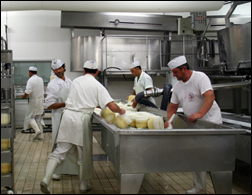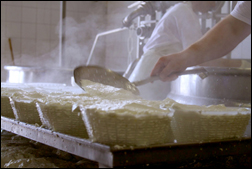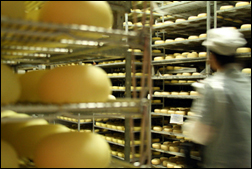By Reid Johnson
The unmistakable smell of rotten milk leaks out into the parking lot
to greet visitors. A blast of overwhelming musky stench flows forth with
the opening of the front doors. Then it happens: white. White walls, white
hats, white shirts, white pants: even the health department-required safety
smocks and plastic beanie caps are white. This is the face of modern cheese
making.
The importance of cheese in Italy and throughout the rest of the world
can be seen in its sheer abundance and necessity in a variety of different
foods. Pasta, the backbone of the Italian diet, would not be the same
without cheese. The face of cheese has changed however. No longer is cheese
made in a small barn or farmhouse, similar to that of the Catena family,
cheese makers in Cagli. Instead, new shiny equipment and bare walls have
taken over; the hay that once covered the floors of small stables is being
traded instead for puddles of sour milk and cheese bits. The Cagliesi
speak of the dangers of growing technology. The changes in the process
of making cheese in Italy aren’t necessarily for the better.

Although the steps for changing a pail of milk into a brick of cheese
have remained constant, the way in which those steps are carried out has
been significantly modified through the use of modern technology. Gone
are the days of dark barns and milking goats and cows by hand to begin
the cheese-making process. These days, a cheese worker goes out to a farm
to collect a sample of milk, which must be brought back to the factory
for testing.
“I have to test for proteins and fats in the milk,” says Roberto
Manna, a lab technician at Fattorie Marchigiane. “If the milk passes
the test, I can then buy a container of milk from the seller.” Suddenly
a process that used to begin immediately can now take upwards of a day
and a half just to begin.
The changes and upgrades do not end there, however, because some factories
have been known to use synthetic milk to help give their cheese a little
push.

“Every place has its own tricks,” says Elsa Catena, matriarch
of the Catena cheese-making family. “As long as the cheese is made
honestly, I am OK with the factory. Some factories put bad stuff out for
the public. They add water, change milk. You have to watch out for tricks.
Tricks can be adding synthetic milk to soup up the cheese.”

The dark hand of technology has had a part in the actual formation of
the cheese as well. With the use of robotic arms and large factory rooms,
the personal approach to cheese making has been lost, to be replaced by
mass production.
“We are now doing more production, faster with machines,”
Manna says. “Cheese making used to be a hands-on thing. Now we have
100 pieces to turn over in an hour.”
With the increase in production however, there has been a significant
drop in the quality of the cheese produced. “There is a rule –
if you are doing more quantity, then you get less quality; if you do more
quality, you get less quantity,” Manna says. “We do our best
to stay in the middle of quality and quantity.”
Mass production has even modernized aging the cheese. Cheese that once
would have simply aged in a dark room, with a small table filled with
15 or so bricks or wheels of cheese, is now typically left in a large
warehouse with upwards of five huge refrigerators filled with thousands
of cheeses.

“We age our cheese in a wooden box with walnut leaves,” says
Biogio Catena, Elsa’s husband. The quality gap between the locally
made and mass-produced cheese is something that leaves many feeling uneasy.
“The quality is less now because with machines, we are standardizing
the process,” Manna says. “Instead of making cheese one at
a time, we are doing more cheese, 10 to 20 kilos a day.”
In spite of the arguable setbacks that newer technology has brought to
cheese making, some upgrades can be seen as a blessing. The production
of cheese throughout the world is up, making it more accessible and less
expensive than ever before.
Many Cagliese, however, have stayed true to the past and the old traditions
of cheese making. When questioned about their future and the effect modern
cheese-making techniques may or may not have on their own process, Biogio
Catena says, “For this family it has always been the same, and will
always be the same.”
Video by Stephanie Meros
Photography by Katrina Hickman
Web Design by Lauren Pappas |

